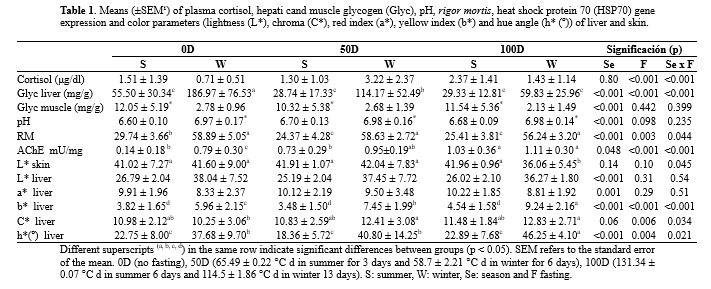EFFECTS OF SEASONAL TEMPERATURE CHANGES AND PRE-SLAUGHTER FASTING ON STRESS RESPONSE AND MEAT QUALITY IN RAINBOW TROUT Oncorhynchus mykiss
Introduction
In aquaculture, fasting is a management strategy implemented before routine operations to optimize efficiency, enhance flesh quality and support animal welfare. However, its benefits depend on the duration of food deprivation and environmental conditions, as fasting is influenced by water temperature and, therefore, the increasing impact of global warming on aquatic environments . Studies suggest that fasting for approximately 55-58 degree days (°C d) minimizes the impact on stress response while enhancing muscle structure, biochemical processes and overall quality. However, seasonal temperature variations lead to shorter fasting periods in summer and longer ones in winter. Given that rainbow trout are a cold-water species with an optimal temperature range of 12 to 18°C, analyzing the effects of fasting across different temperature would be particularly valuable. This is especially crucial in light of the increasing risk of heat stress in rainbow trout farming due to global warming.
Material and methods
A total of 495 rainbow trout were distributed across nine cages with an average water temperature of 22.0 ± 0.06 °C in summer and 8.8 ± 1.79 °C in winter. After a two-week acclimation period with daily feeding, fish were subjected to different pre-slaughter fasting durations: no fasting (0D), 3 days (65.49 ± 0.22°C d) in summer and 6 days (58.7 ± 2.21°C d) in winter (50D), 6 days (131.34 ± 0.07°C d) in summer and 13 days (114.5 ± 1.86°C d) in winter (100D). Blood samples were collected to analyze plasma cortisol levels, liver and muscle samples were taken to assess glycogen concentration. Additionally, muscle samples were analyzed for pH, rigor mortis and acetylcholinesterase activity. The color of the liver and skin was also measured using the CIELAB system.
Results and discussion
In winter, plasma cortisol levels were higher in the 50D group compared to 0D, likely due to the acute stress response triggered by sudden food deprivation . However, cortisol levels in the 100D and 0D groups remained similar across both seasons, which could indicate metabolic adaptation or hypothalamic-pituitary-interrenal axis exhaustion. Additionally, higher cortisol levels in the 50D winter group compared to 50D summer suggest that prior acclimation to elevated temperatures might limit stress responses to additional stressors . Hepatic glycogen levels were lower in summer than in winter, where a progressive decline was observed with prolonged fasting. The 100D group in winter showed values comparable to the 0D summer group, likely due to glycogenolysis maintaining blood glucose as an energy source. Muscle glycogen levels remained relatively stable across fasting durations, but they were higher in summer, possibly due to reduced swimming activity in warmer water. Glycogen directly affects post-mortem pH, with a significant negative correlation between glycogen levels and pH decline, influencing rigor mortis. In summer, higher glycogen levels led to greater lactic acid production and a less pronounced pH drop compared to winter. Fasted fish in winter showed higher pH, possibly due to increased pre-slaughter activity. Higher temperatures generally accelerate rigor mortis due to faster pH decline, but in this study, summer trout exhibited lower rigor at 0 h, suggesting additional influencing factors . During winter, AChE activity increased significantly with fasting duration, suggesting that AChE levels rise in catabolic tissues during prolonged starvation, contributing to muscle degradation and heightened food-seeking behavior. Unfasted fish in summer exhibited higher AChE activity than those in winter, remained elevated across fasting groups. This could be due to greater sensitivity to temperature stress. Regarding skin color, no significant variations were observed between fasting groups in summer, suggesting acclimation to higher temperatures. However, chroma values were higher in summer than in winter, with 100D groups in both seasons reaching similar levels, possibly linked to stress responses. Additionally, 100D winter group showed lower lightness (L*), likely due to the dispersing effect of adrenocorticotropic hormone on chromatophores. Similarly, liver color in summer remained unchanged across fasting groups. L* and redness were not affected by fasting but were influenced by seasonality, whereas chroma and hue were higher in winter. These changes are likely due to metabolic responses, mobilizing hepatic reserves and altering lipid composition . Overall, when fasting is the primary stressor, an initial acute stress response is followed by gradual metabolic adaptation, reducing stress over time. However, in summer, prior acclimation to higher temperatures lessens the response to additional stressors
Bibliography
Bermejo-Poza, R., M. Fernández-Muela, J. De la Fuente, C. Pérez, E. González, M.T. Díaz, F. Torrent, M. Villarroel. 2019 . Physio-metabolic response of rainbow trout during prolonged food deprivation before slaughter. Fish Physiol Biochem 45:253-265. Erikson, U., E. Misimi . 2008. Atlantic salmon skin and fillet color changes effected by perimortem handling stress, rigor mortis and ice storage. J Food Sci 73(2):50-59. Hultmann , L., T.M. Phu, T. Tobiassen , Ø. Aas -Hansen, T. Rustad . 2012. Effects of pre-slaughter stress on proteolytic enzyme activities and muscle quality of farmed Atlantic cod ( Gadus morhua ). Food Chem 134:1399-1408. Poli, B. M., Parisi , G., Scappini , F., & Zampacavallo, G. (2005). Fish welfare and quality as affected by pre-slaughter and slaughter management. Aquaculture international, 13, 29-49. Villalba, A.M., Á. De la Llave-Propín , J. De la Fuente, C. Pérez, E. González de Chávarri, M.T. Díaz, A. Cabezas, R. González-Garoz , F. Torrent, M. Villarroel, R. Bermejo-Poza. 2025. Seasonal comparison of uniform pre-slaughter fasting practices on stress response in rainbow trout (Oncorhynchus mykiss).

